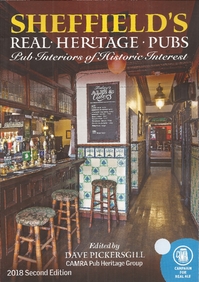Book captures glory of Sheffield pubs
Added: Sunday, October 28th 2018

Sheffield’s Real Heritage Pubs (second edition). Edited by Dave Pickersgill
CAMRA £5.99
The cover of this superb book makes you want to the jump on the first train or bus to Sheffield to be wrapped around by the White Lion’s tiles, beams, wooden floors and oak bar groaning with hand pumps. The sign at the end of the corridor says it all “Welcome!”
The welcome is extended by Dave Pickersgill and his team, who not only write elegantly and lovingly about Sheffield’s pubs but also place them in the history of Steel City. The industry may have gone but, despite the best efforts of some big brewers and pub companies, many of its fine hostelries remain, rich in brewing and architectural delights.
The book is full of little anecdotes that bring the pubs in to sharp focus. Many of the pubs have a plethora of glazed tiling and brick, not just for decoration but because the tiles and bricks – unlike paintwork – could easily to be washed to remove the grime pouring down from factory chimneys.
The pubs were created to meet demands of workers in the “heavy, sweaty steel industry” which meant “big thirsts and helped ensure a ready market for the products of the area’s various brewers.”
From 1780, when Thomas Rawson, the first major commercial brewer in the city, rebuilt his plant to cope with the demand from steel workers, brewing grew at a fast pace. Rawson and his rivals were pioneers of the tied house system, which meant only their porters and ales could be sold in their outlets – a system that didn’t develop until years later in other parts of the country, including London.
Many of today’s Sheffield pubs have survived the horrors of the 1960s when big brewers such as Bass, John Smiths and Whitbread brought in the dreaded refurbishment brigades to strip them of their original designs. Thanks to the valiant and painstaking efforts of pub campaigners, including CAMRA’s Pub Heritage Group, many of those pubs have been restored to their former glory.
It’s not only brewers who have wreaked havoc with the city’s pubs. The Shakespeare on Gibraltar Street in the Kelham Island district is a venerable coaching inn dating from 1821. It was owned by local brewer Wards and later fell into the clumsy hands of Punch Taverns, which had the brass-necked temerity to close it in 2010.

Fortunately it was bought and saved by independent owners 18 months later and has been restored and revived. Now known as Shakespeare’s Ale & Cider House, the central bar has eight hand pumps that have served more than 5,000 different beers over the past seven years, complemented by two annual beer festivals. The pub offers a warm welcome -- unless you are employed by Punch Taverns.
One featured pub predates the Industrial Revolution. The Old Queens Head on Pond Hill has a stunning half-timbered facade and dates from the late 15th century when it was built as a hunting lodge for Sheffield Castle and was first known as T’Hawle in t’Poandes or Ponds.
It’s not the only pub with an unusual name. Church House on St James Street has had a variety of names since it opened in 1859 on the site of an old vicarage. Over the years it has been called Gladstones, the Priory, the Sanctuary and even the Ferret and Trouser Leg. The last-named must surely have come from the vivid imagination of Bill Tidy, who draws the Keg Buster strip in CAMRA’s paper What’s Brewing.
Many of Sheffield’s pubs are small and simple, drinking shops for parched steel workers. But architectural elegance abounds. The Grapes on Trippet Lane was built by Rawson’s brewery and offers magnificent tiling and etched and frosted glass, much of it inspired by the Art Nouveau movement of the 19th century.
In sharp contrast, the imposing Rutland Arms on Brown Street was built in 1936 and reflects the influence of the no-frills and functional Art Deco style of the time.

The book quite rightly devotes several pages to the impact of the Fat Cat pub on Alma Street in Kelham Island. It was bought and restored in 1981 by the late and much-missed Dave Wickett. Dave not only created a delightful pub, rich in brewing history with its rooms full of memorabilia, but brought quality beers from small producers from many parts of the country.
Dave died in 2012 but he inspired a wave of new pub entrepreneurs and craft breweries to ply their trades in the city.
Go, marvel and enjoy and if you visit by train make sure you have one last beer at the Sheffield Tap on Platform One at the central railway station. The former Midland Railway First Class Refreshment Room has been wonderfully restored with tiling and a terrazzo floor plus its own adjacent small brewery.
It’s worth missing a few trains for.
•The book can be downloaded free of charge from
https://sheffield.camra.org.uk/rhp/
Printed copies can be obtained for £6.50, £7.50 non UK, including postage from Dave Pickersgill’s Pay Pal account:








